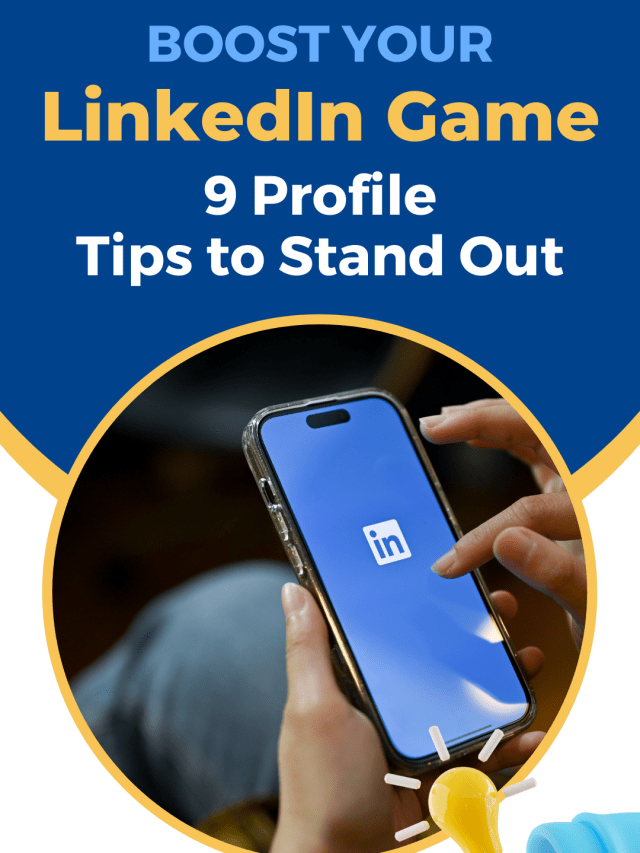If you’re looking for some LinkedIn profile tips, you’re most likely in one of these situations:
- You’re not landing the clients, job, or employees you want.
- Your profile lacks views or popularity.
- You don’t know what to write for your LinkedIn profile
If you answered, “that’s me!” to any one of these above points, I completely understand!
I want to share with you my 15 best LinkedIn profile tips so you can:
- Find great work
- Make more money
- Get more profile views
- Build an incredible network
LinkedIn boasts over 660 million users in more than 200 countries and territories worldwide. With that kind of reach, you can’t afford not to take your LinkedIn profile seriously.
Watch our video below to learn the LinkedIn profile tips that will get you recognized:
Without further ado, here are my top tips on how to improve your linkedin profile and strategy.
Be a Strategic LinkedIn Liker
Building a strong network is about making and maintaining connections. Connecting with someone after a networking event is just half the battle, after all.
How do you maintain better LinkedIn connections? One word: Engage.
Here are 2 things you should avoid, and how to use your likes to your advantage.
- Don’t be a LinkedIn crawler. You know, those people who just scroll through their feed and aimlessly browse without liking anything.
Instead, try this: Every time you go on LinkedIn, take a few moments to like a few recent posts in your newsfeed. Whenever you’re liking a post, you’re also showing your connection some appreciation!
- Don’t treat your likes like gold. Unlike gold, likes are free.
Instead, try this: My rule of thumb is, if the post I read provided just an ounce of value, I give it a like! But it’s important to be purposeful about this—don’t just go around liking any and all posts.
Likes are the easiest way to produce rapport.
Look at the bigger picture. I used to be a serial judger, but liking creates deeper connections. It’s great conversation fodder next time you see them. If you liked an article they posted—even if the post wasn’t excellent—you then can talk about that article next time you see them. Bingo! Conversation starter and liker.
Engaging with other people’s posts enhances your professional image in two ways:
- It ensures your name regularly appears in your connections’ news feeds so you stay relevant in their minds.
- It shows people who look at your profile that you are active on the site and interested in others’ work. When you interact with interesting content, a new section appears on your profile that shows your activity. Aim to be active regularly, so when people check out this section of your profile, they see recent updates.
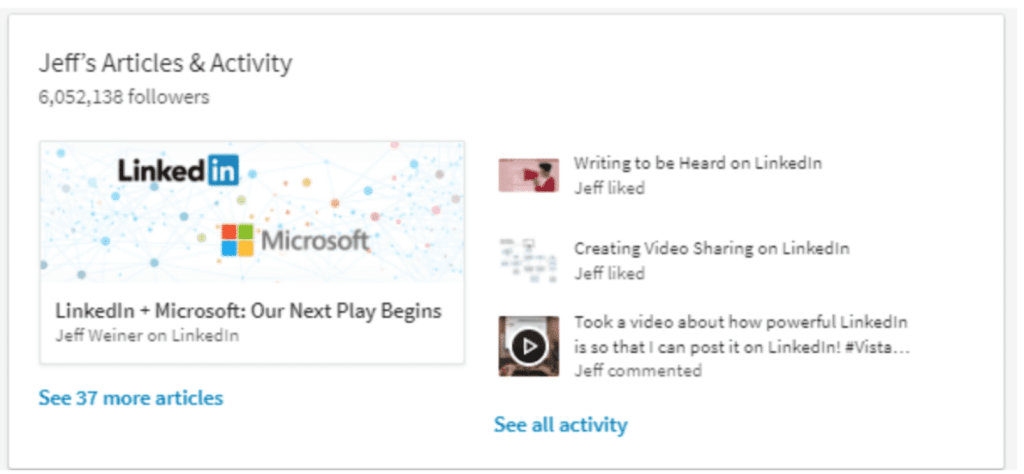
The point is to stay active so your connections grow accustomed to seeing that you’re always sharing new insights, and so when potential new connections see your profile, they see that you have a lot of knowledge and skills to offer beyond your job experiences.
Right Now: Like at least three updates from your newsfeed.
Post Thematic Updates
What’s one of the biggest misconceptions people have about LinkedIn?
Having a great profile is enough.
Reality check: A great LinkedIn profile is NOT enough.
Reports show that only 1% of users share content on a weekly basis, suggesting that the majority of people create their profiles and then occasionally add new connections. This is a wasted opportunity!
Why? Because LinkedIn gives valuable real estate to updates. Immediately after logging into LinkedIn, your contacts get taken to their newsfeed, which is filled with recent updates. This is an easy way to stay in the front of people’s minds.
You can see I posted 4 times in the last week and got tons of shares, comments and likes:
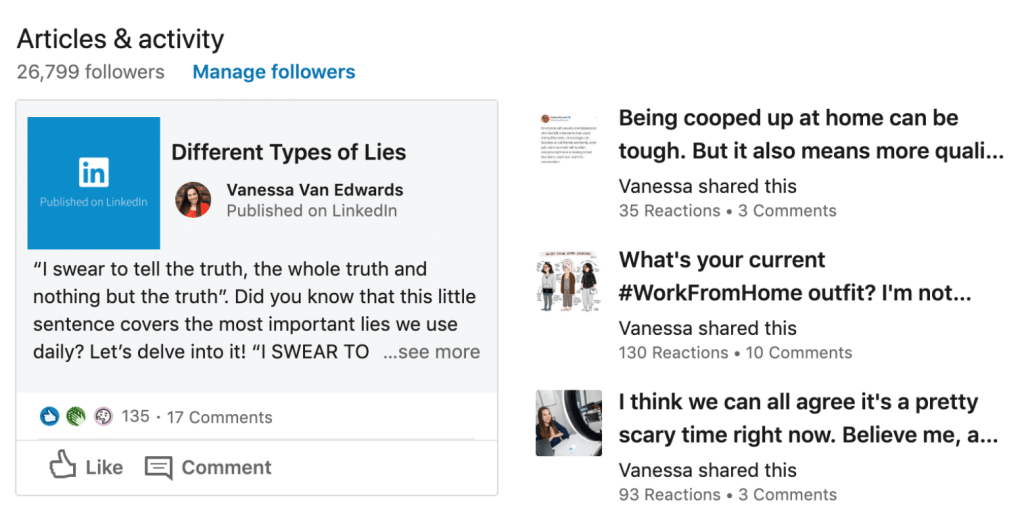
How Do I Get My LinkedIn Content Ranked?
Not all posts were created equal. Some posts you see IMMEDIATELY when you login to LinkedIn, while others get buried under a mass of articles, text, and pictures, and don’t get to see the light of day. To get your content seen by others, there’s one important thing you need to know how to beat, and it’s called…
The LinkedIn Algorithm
Yes, there’s a LinkedIn content algorithm! Don’t worry—no math involved here! Beating the LinkedIn Algorithm is actually quite easy, as long as you know how it works. Put simply, the algorithm works with four different filters:
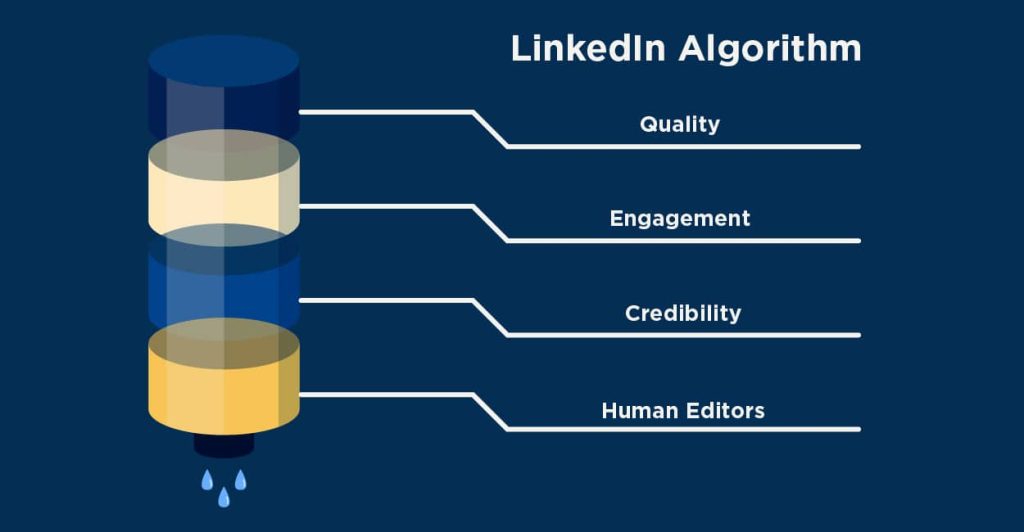
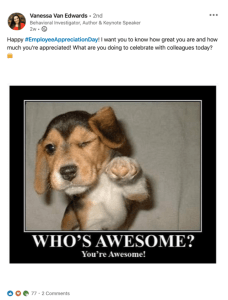
- Filter 1: Quality. Your posted content should not be spam or offer little value. Otherwise, the LinkedIn bots will scrap your content almost immediately!
- Filter 2: Engagement. Engagement is measured based on the likes, comments, and shares your post gets. You can even just post a meme with a few words! That always gets a laugh or a smile.
- Filter 3: Credibility. LinkedIn likes people who post good content. So if you’re just starting out, having consistently good posts ensures your future ones get that well-deserved cred.
- Filter 4: Human Editors. The last filter is by real people at LinkedIn. These guys decide if your content is worth spreading to others, or if it’s time to join the LinkedIn content graveyard.
Here’s the best news: The more you post, the better you rank.
In the beginning I did not get a ton of engagement. But as I started posting more and more, my content got better ranked and my users became more engaged.
What’s the Best LinkedIn Content Strategy?
To beat these filters, I’ve come up with the best 4-step LinkedIn strategy that revolves around Theming. This is the best LinkedIn profile tip to have A-level content. Here’s how the strategy works:
Reach Your Audience
What would your network like to hear about? What fits with your brand strategy? What could help you? What could help your contacts?
It’s critical that your content stay on topic. As an example, here’s my title on LinkedIn:

As you can see, I’m a Behavioral Investigator. That’s just a fancy way of saying I study people skills. And you can see it clearly in my “About” section, where I outline my mission:
“[My] mission is to teach you the people skills you never learned in school.”
So what kind of content do I post to my LinkedIn followers? Social skill content, of course!
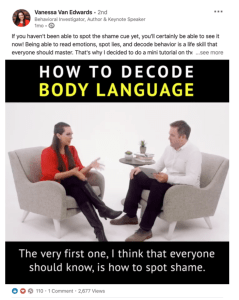
Since I’m a people-skills person, I post stuff about people skills. But occasionally I also post about:
- Current events
- Entrepreneur topics
- Industry wide news
- Funny cat videos
I just stay relevant to as many people as possible most of the time, and throw in just a few of my “personality bites”—those pieces of content that show character.
Hint: Go For 80/20. While it’s awesome to post a funny GIF or meme (as I do!), LinkedIn prefers the professional: business tips, career advice, news related to your industry. But it doesn’t stop there. You should also spice it up! Don’t be the bore and go 100% suit-and-tie—aim for 80% professional, 20% funny/motivational content.
Pick a Theme
When choosing a theme, keep in mind what type of content you want to post. Is it informative? Entertaining? Sharing your own personal advice? Here are the themes that work most often:
- Industry News: You attended an industry conference and gained some great insights. Share them.
- Insider Knowledge: You read a book and learned something others in your network could benefit from knowing. Post a summary.
- Inspirational: You saw a quote or heard a story that inspired you and you think it could inspire others.
- Personal: You’re working on a personal project. Sharing details about it is a great way to allow your network to get to know you outside of your job.
- Advice: You are looking for a specific type of connection. Do you need someone who has a particular area of expertise to help you achieve a goal? By posting about it, you prompt your connections to promote themselves or recommend others who would be a good fit.
Make a Quality and Engaging Post
LinkedIn posts should be like a short little summary, rather than the full book. Here are some ways to up your LinkedIn content game:
- Keep it short and sweet.
- Use a video to grab attention instead of an image.
- Not a fan of video? Try standing out from the crowd with text-only posts.
- Use a face. Did you know that our eyes naturally gravitate towards human faces? That’s why I love to post content with images that feature faces! (here’s a post of mine!)
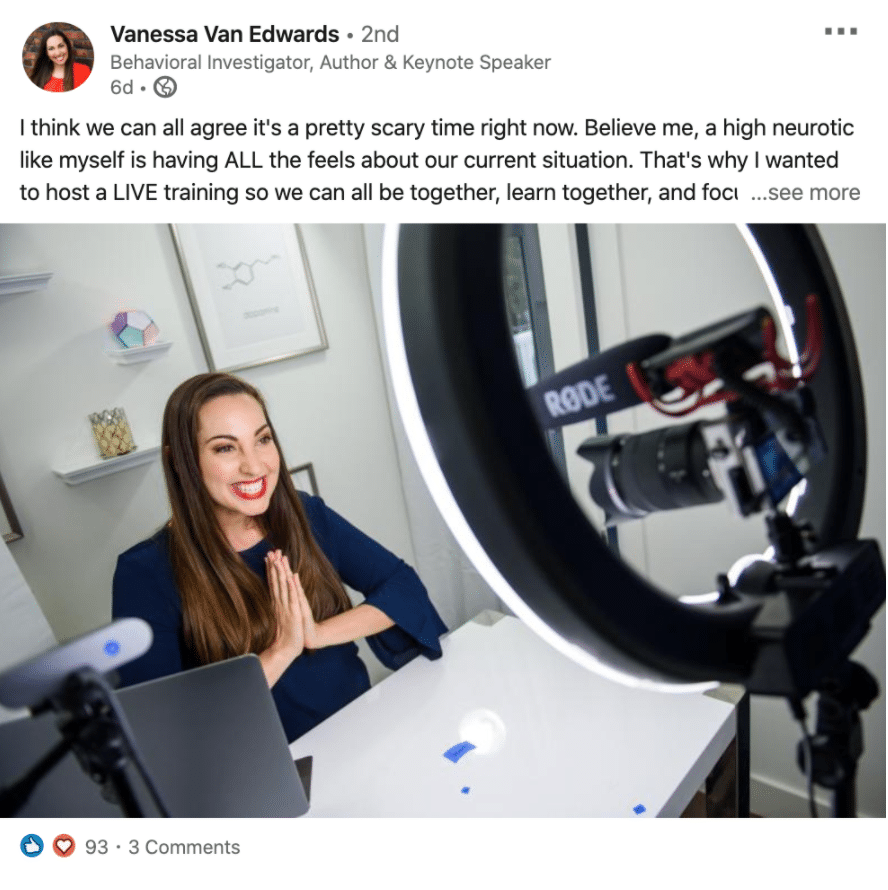
Aim for 9 to 5
To gain the most traffic to your epic piece of content, you’ll need to avoid the midnight hours where everybody’s asleep. If you like to write up content at night, save it for the morning! Ideally, choose a time between 9 a.m. to 5 p.m. where most professionals are at work.
Bottom Line: Don’t just have a LinkedIn profile, actually use it.
Right now: Pick your theme and post an update.
Your Profile Is More Than a Resumé
A lot of people make the mistake of thinking their LinkedIn profile is just a virtual place for them to display their resumés. It is in part, but it is also so much more than that.
Beyond the summary and job experience sections that most people focus on filling out, there are also more than half a dozen other sections that showcase your interests and accomplishments in specific areas that are not featured with your job descriptions.
Filling out your profile not only helps people who search for you, it also makes LinkedIn more likely to show your profile in search results. LinkedIn favors profiles that are ‘complete.’
Here’s an example of an incomplete profile that illustrates why it is so important to fill out every section of your profile with enough details to showcase who you are.
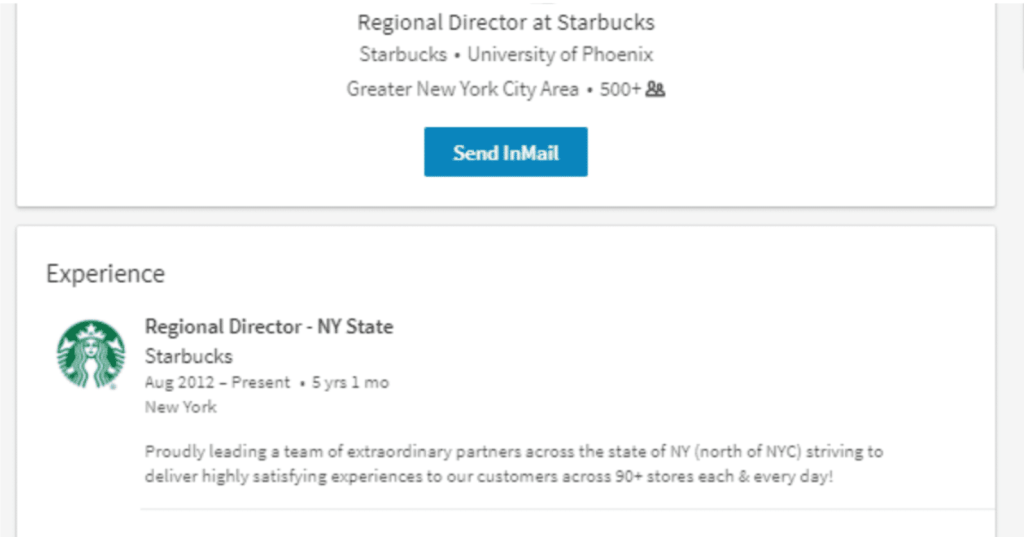
If you were to scroll to look at the rest of this profile, all you would see is more jobs with similarly minimalist descriptions and a few job skills.
We know the person is a regional director at Starbucks, but without a summary or any other sections filled out, we don’t know much else:
- We don’t know what his job duties are.
- We know nothing about his past experience and education.
- Skills and expertise? Nada.
In a nutshell, we know nothing about who the person is and why we would want to connect with him.
Remember, you are far more than your job title and you need to prove that on your LinkedIn profile.
How Do You Make One of the Best LinkedIn Profiles?
This is a simple LinkedIn profile tip to remember: Get All-Star status. If you haven’t noticed already, LinkedIn comes with a handy built-in indicator of your profile strength on your Profile page.

The more complete your profile is, the higher the profile strength. Here’s a chart that details the levels of profile strength:
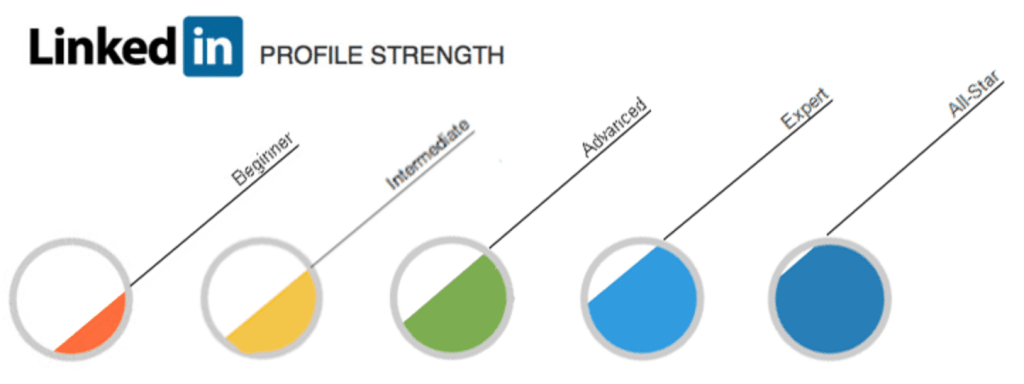
The goal here, if you haven’t already reached it, is to achieve All-Star status! To get All-Star status, LinkedIn recommends three “must-haves”:
- Your photo
- Current position
- The industry you work in
However, that’s pretty bare-bones material. You should fill out everything from your education, skills and endorsements, recommendations, work history, and even get a custom URL (ideally something like www.linkedin.com/in/yourname) to make it the best LinkedIn profile you can create.
Here’s why it’s important: According to LinkedIn, users with complete profiles are 40 times more likely to receive opportunities. That’s 40 times more job offers, clients, connections, and more!
Compare the Starbucks example to my profile which, after the summary and job experiences, has additional sections filled with revealing information:
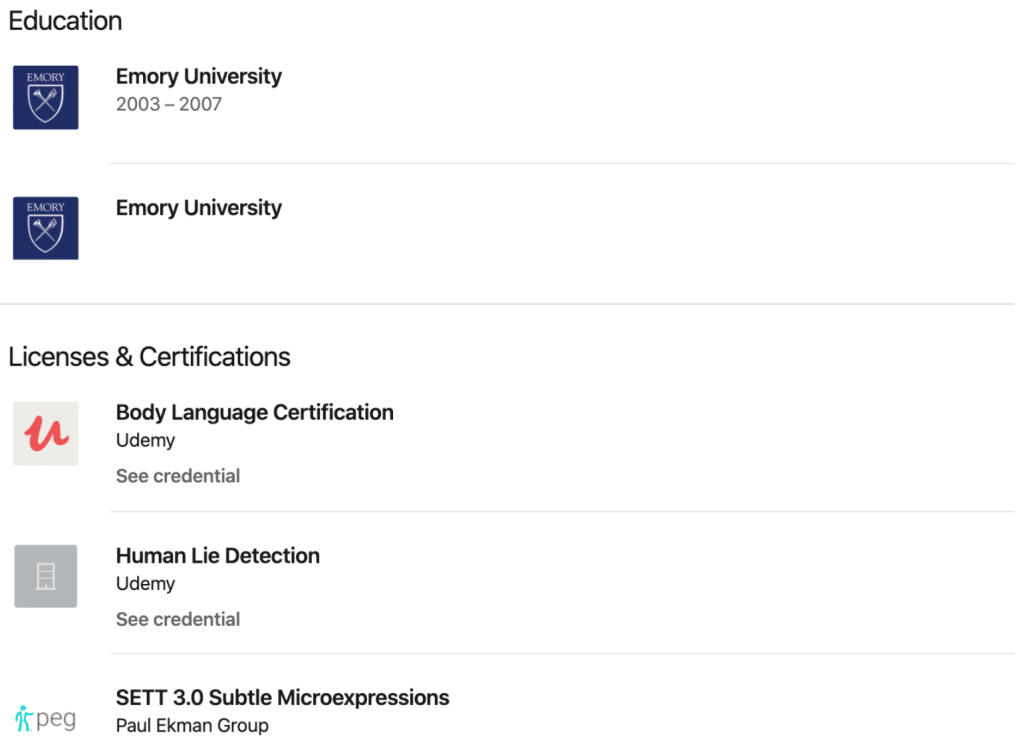
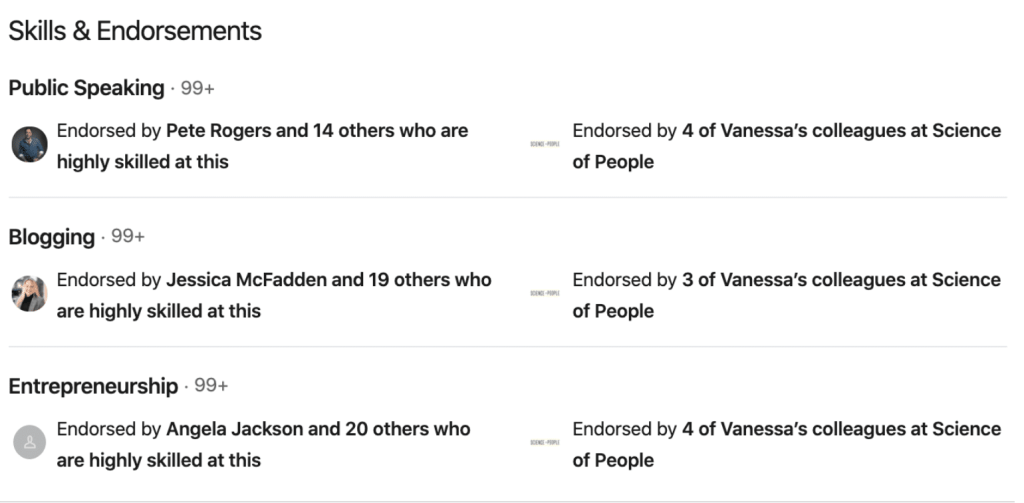
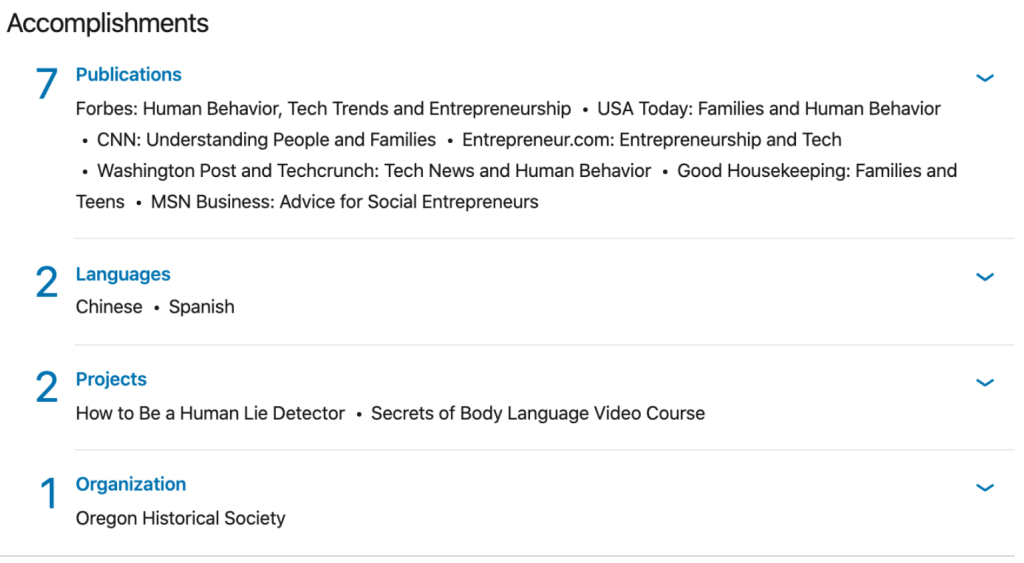
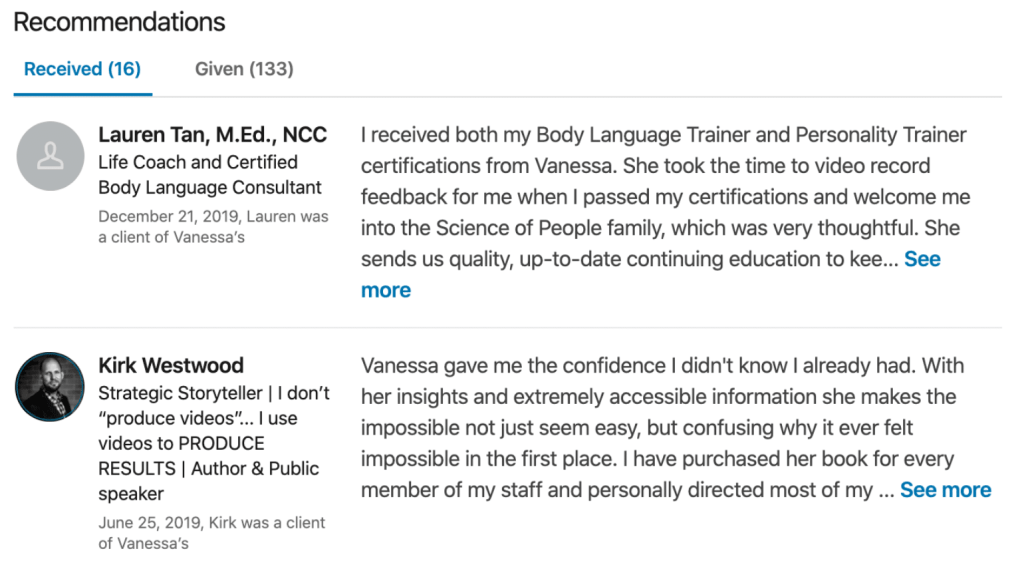
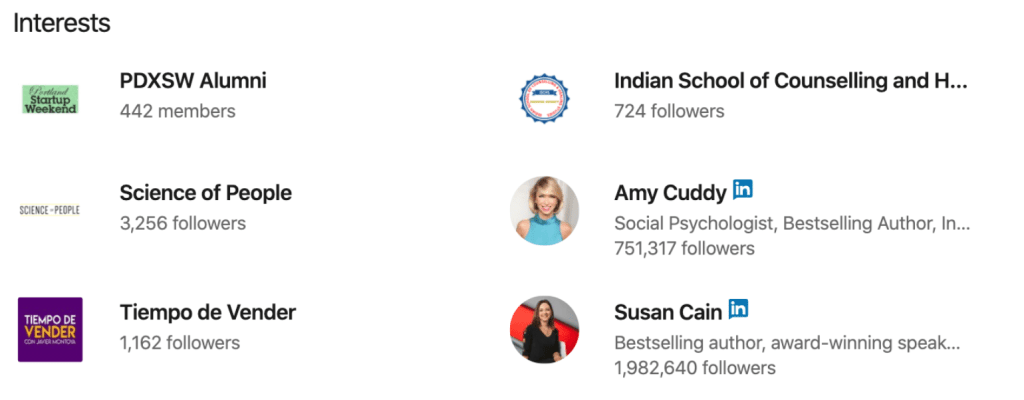
Fill out every single section option in your LinkedIn profile. If you think that you have no relevant accomplishments or activities beyond your job experiences, first reevaluate the personal projects you have worked on.
Chances are, you demonstrated a valuable skill and/or relevant facet of your values that you can list on your profile. If you still struggle to come up with additions, this is your cue to get involved with more activities that can propel your career forward.
Here are a few easy ways to gain accomplishments and experiences that spice up your profile:
- Take a course that advances your skillset. We have a master communication course called People School if you want to increase your interpersonal intelligence.
- Volunteer with a local organization that supports your professional role or fulfills a personal passion.
- Join the board of a nonprofit that could use your professional expertise.
- Participate in competitions related to your personal and/or professional life. Even if you lose the first few, you’ll gain new skills and likely make valuable connections along the way. For example, if you’re an entrepreneur, enter business plan competitions; if you’re a programmer, participate in code challenges offered by platforms such as Codechef and Topcoder; or if you’re in marketing, enter competitions hosted by professional societies, such as the Society for Marketing and Professional Services. Regardless of your field, there are likely ways to earn recognition. Start by searching for competitions in your industry.
Right Now: Complete all sections of your LinkedIn profile.
Remove All Buzzwords
Want to know how to make the most boring, bland profile ever?
Use the same old words as everyone else!
This LinkedIn profile tip comes straight from the deities themselves. LinkedIn revealed the 10 most overused marketing buzzwords on resumes and profiles. You want to differentiate yourself from the other professionals in your industry.
Here are the top ten most overused buzzwords and what you can replace them with:
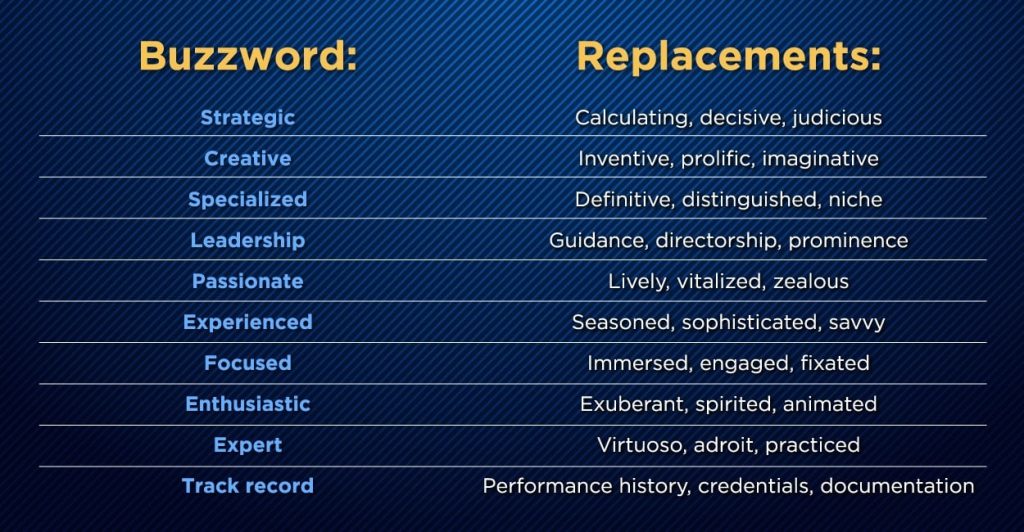
Take a look at this bland About section that could use an overhaul and less buzzwords:

I’m a fan of Bill Gates’ About section. Pretty much everyone on the planet knows about Bill Gates, so here’s his short, simple piece (notice the more crafty wording?):

If you’re struggling to come up with original words to spice up your profile, plug your current, buzzy ones into Thesaurus.com and choose replacements. It’s that easy.
Pro tip: To the greatest extent possible, choose words that you would feel comfortable using to describe yourself verbally. Your vocabulary reveals a lot about your personality and communication style. You don’t want to confuse people by presenting yourself in different ways online versus in-person.
Right Now: Replace these 10 buzzwords in your profile.
Be an Adder
One of the best LinkedIn profile tips to showcase your knowledge or expertise is not only to post about it (see LinkedIn tip #1) but also to comment on other people’s posts. I call this being an “adder” as opposed to a ‘“subtractor.”
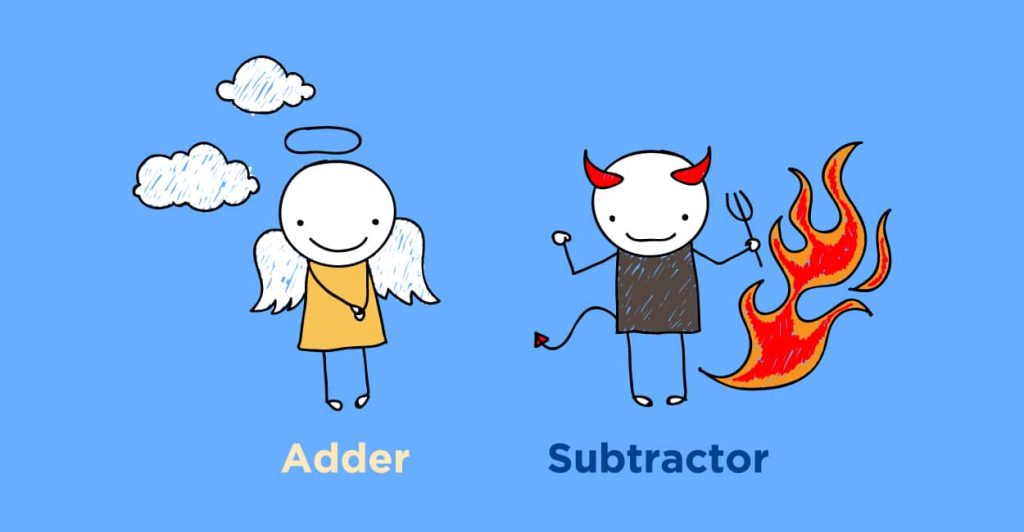
Adders: Add to the knowledge of an update with an interesting anecdote, idea, or example. They add gratitude with a thank you or a supportive response.
Subtractors: Ignore good posts or take away from them by adding negative, unhelpful, or unsupportive comments.
Which are you? If you want to impress someone, make them feel impressive by honoring their great post. Here’s how:
- Add more to it.
- Thank them.
- Give a relevant link or personal anecdote.
- Ask follow up questions.
- Offer constructive feedback or a different perspective.
Here’s an example: a contact of a contact (2nd degree) liked this interesting status update from photographer Gordon Clark:
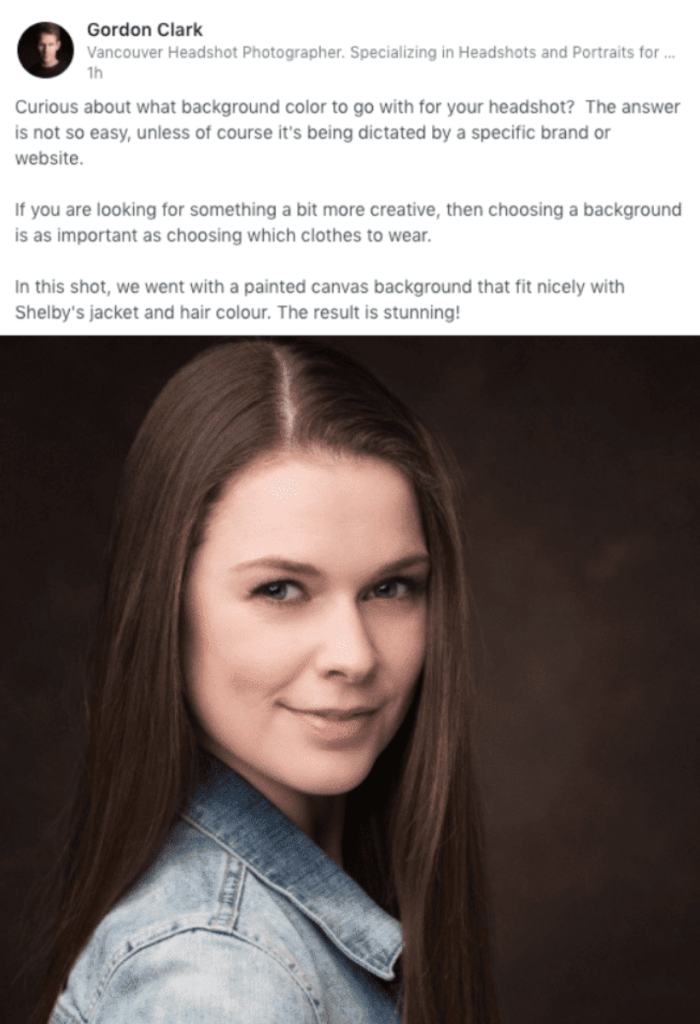
I loved the question and had an idea on it. So I posted this comment:

Then I added him as a contact and he accepted! I added value and added a contact—win-win!
Right Now: Add to someone’s post.
Request Smart
One of the best parts of LinkedIn is adding connections—these can be people you met in real life, colleagues, or new contacts. How you request someone to connect on LinkedIn is incredibly important. Here are some best practices for adding people as connections.
- Always add a personal message! Tell the individual how you know them. Don’t send connection requests to people you don’t know or don’t have a strong reason to want to know you. If they decline your request for not knowing you, it will get marked as spam. After having a few of your requests marked as spam, LinkedIn will restrict you from trying to connect with more people.
- Tell them why you want to connect with them. Forgetting to do this may cause some people to decline your request because they don’t know what to expect from you if they do accept. Make sure your reason is specific to the individual. General reasons show a lack of effort. Here’s the difference between a vague and specific response:
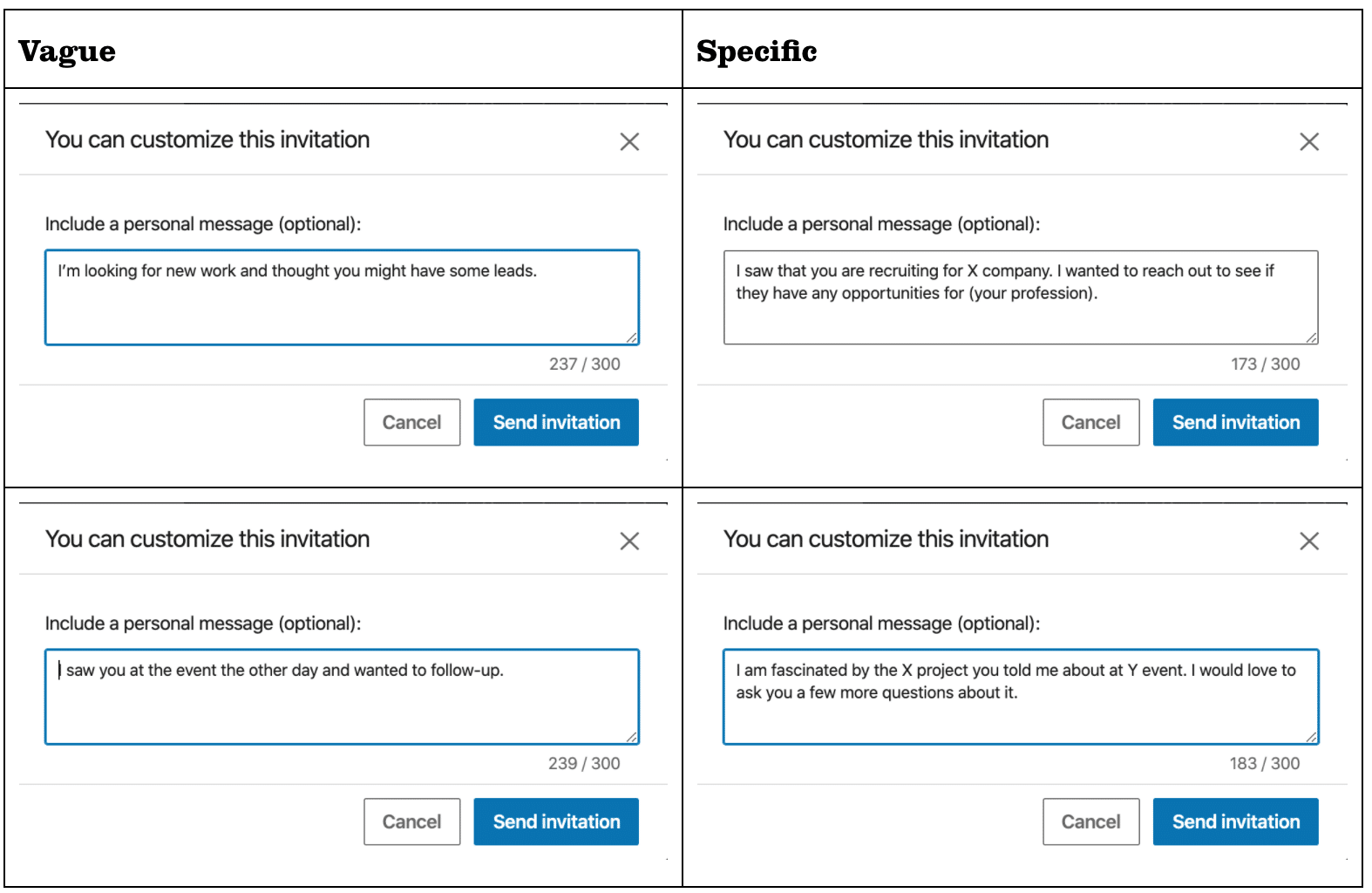
- Give them a reason to want to connect with you. Some ways to do this include offering to help them, following up on something you spoke about in person and expressing your appreciation.
- Don’t wait too long! I used to have a stack of business cards from events and would connect with everyone at the end of the month. But this was too long! People didn’t always remember and it made me look like a procrastinator. Add people no more than 24 to 48 hours after you meet them.
- Import your email contacts selectively: I like adding your address book to LinkedIn but don’t add EVERYONE. This can be spammy and you might not even remember the people you are connecting with. Every few months I see if I have any new contacts from my address book to add and then send personal messages.
Right Now: Selectively import contacts from your address book.
Join a Network Greater Than Your Own
According to the online marketing consulting and education firm Quick Sprout, one of the most effective ways to yield a positive return for the time you spend on LinkedIn is to become active in relevant groups.
When you want to build your reputation as an expert in a specific subject or need help from professionals in a particular niche, joining groups is often the best way to develop the relationships you are seeking. Unlike your overall network, groups are unified around defined interests, which both gives you access to professionals who have the qualities you are looking for, and allows you to dive into meaningful conversation.
The initial impression you make when joining a group is critical. Keep in mind these things before posting in a LinkedIn group:
1. Read their guidelines. Some groups have restrictions on the topics and types of content they allow. You can find the group rules right below the “About this group” section.
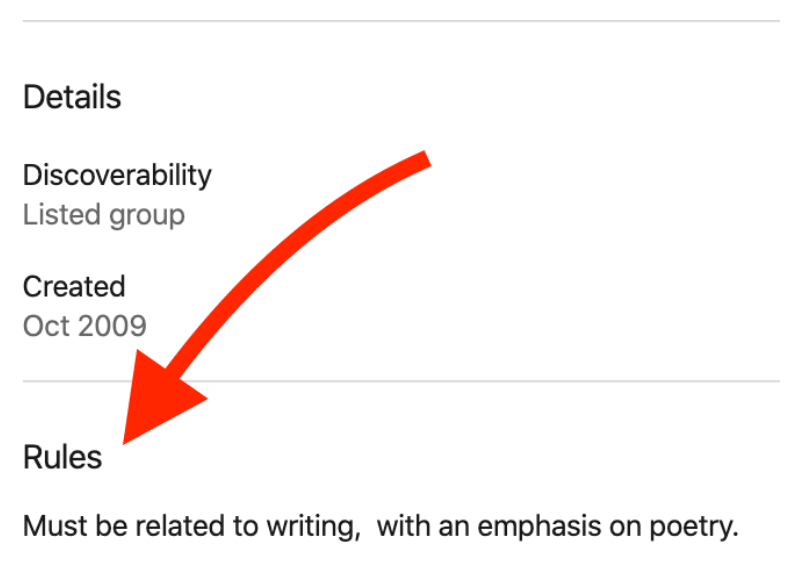
This poetry group’s rules are super simple!
2. Skim the most popular discussions to gain an understanding of what topics spark the most active conversations.
3. Observe the dominant communication style. Are posts and comments formal and full of jargon? Do people write casually, as if corresponding between friends, or something in-between? Match that style.
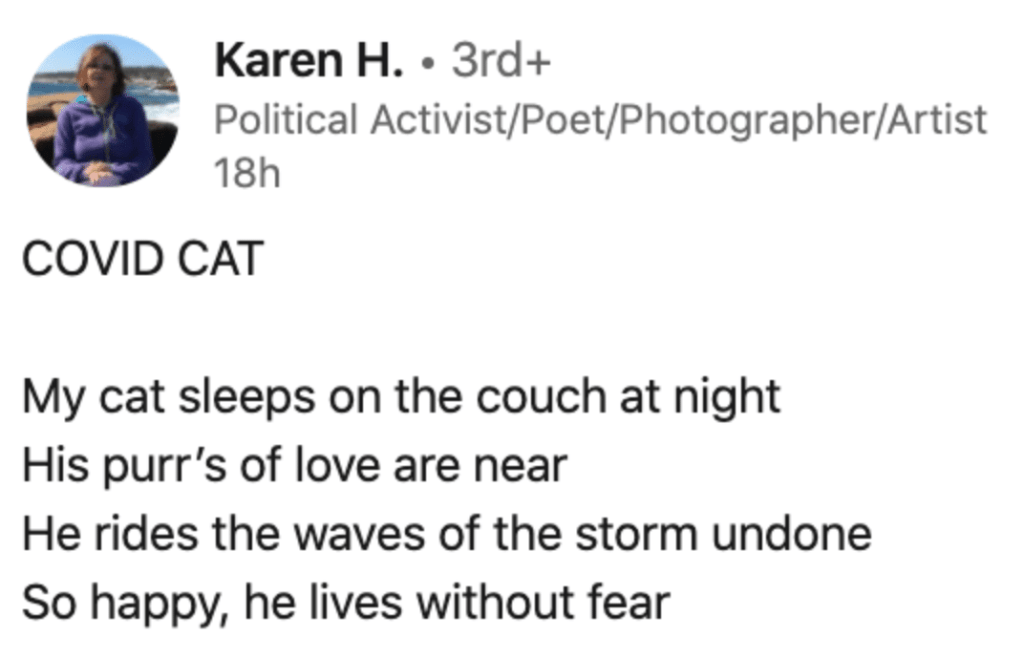
The communication style is super simple—post in poems!
4. Do not join a group with the sole intention of promoting yourself. Yes, you’ll want to yield value from the group, but you must offer value and become a respected member before people want to do you favors.
5. Ask the questions! Groups are made for back-and-forth conversation, so there’s no harm in asking! When you reach out for information, you’ll automatically engage in the Ben Franklin Effect—when people help you, they’ll like you more, too!

6. Answer them, too. Online marketing expert Neil Patel recommends that when you first join a group you should begin interacting by answering questions. This is a more subtle way of establishing yourself than immediately posting and shows that you’re interested in other people and helping them.

7. Make the connection. After you’ve engaged in a couple discussions and offered value to the group, reach out to the members you’ve connected with most and start building individual relationships.
To find the right group(s) for you, check out LinkedIn’s Group Directory. Here are a few popular groups to get you started:
- Marketing: Media and Marketing Professionals Worldwide
- Leaders: Leadership Think Tank
- Public Relations: Public Relations and Communications Professionals
- Sales: Sales Best Practices
- Information Security: Information Security Network
- Data Science Professionals: Data Science Central
Right Now: Join a group and answer 3 questions!
Test Your LinkedIn Profile Picture
If you’re like me, you have a really hard time picking the perfect profile picture. The thing is, this is not a silly worry. Our profile picture says A LOT about us. According to research published in the journal Psychological Science:
- slight variations in how an individual face is viewed can lead people to develop significantly different first impressions of that individual.
While no one can change their face, we do have control over what the photo represents and how we want it to be perceived.
Bonus tip: It’s a really good idea to get a professional headshot rather than just using your phone’s camera. Statistics show that LinkedIn profile photos with professional headshots get 14 times more views!
Here’s another LinkedIn photo tip:
Test your profile picture. We partnered with a website called PhotoFeeler. PhotoFeeler is a free profile photo testing tool that helps people choose better profile photos by cluing them into what their photos are really saying. I gave this tool a little spin. Here are the 3 photos of me and how they ranked:
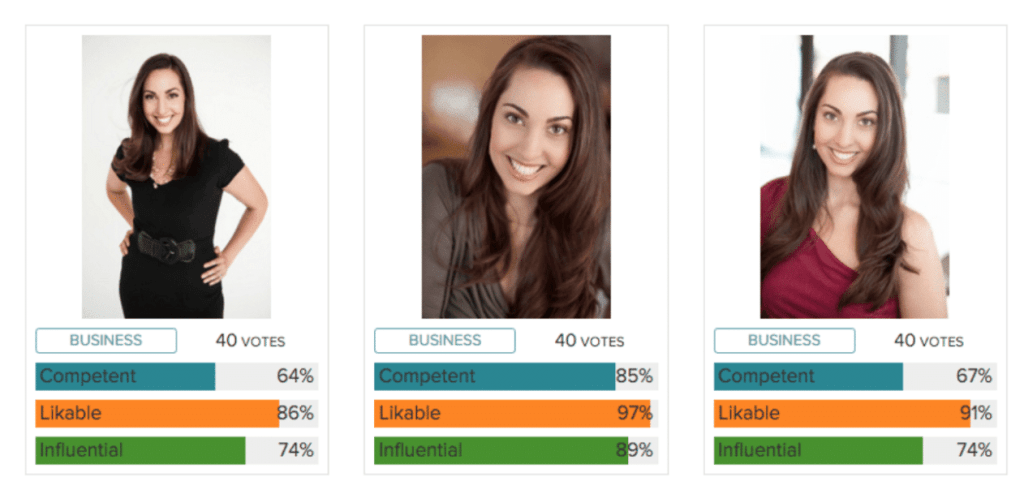
With the current votes, the second photo has scored highest in all 3 areas! How to Test Your LinkedIn Profile Pic:
- Upload your photo at PhotoFeeler.
- Vote on other people’s photos (or buy vote credits)
- Wait for the results
Bonus: 8 Steps to Picking the Perfect Profile Picture
Want some extra tips on picking? We used the photos from PhotoFeeler to do a big study. For example, researcher Farhod Karimov from the University of Brussels found that when people have their picture taken from below, they are seen as more self-confident, sociable, and attractive.
This comes from our childhood spent literally looking up to adults we admired. If you want people to think you are more trustworthy, open-minded and sympathetic, take your photo straight-on.
Facing the camera conveys the body language signal, fronting, which is when you face your entire body toward someone to show that you respect them and are fully engaged in your interaction.
Check out all of our profile tips.
Make Someone’s LinkedIn Day
Imagine this: You spend countless minutes crafting the perfect LinkedIn status update. You submit it, and… BAM!
Someone shares it with their audience.
Instant. Dopamine. Hit!

Sharing is the ultimate show of support! When you share other people’s posts you get great social capital. In addition to showing your interests and increasing your activity level, this is a great way to show people that you are thinking about them without having to personally reach out.
Whenever you want to be more memorable, keep this LinkedIn profile tip in mind. That’s because dopamine is the chemical in your brain that actually aids memory and information processing—the more dopamine that’s released in the brain, the more memorable you’ll be!
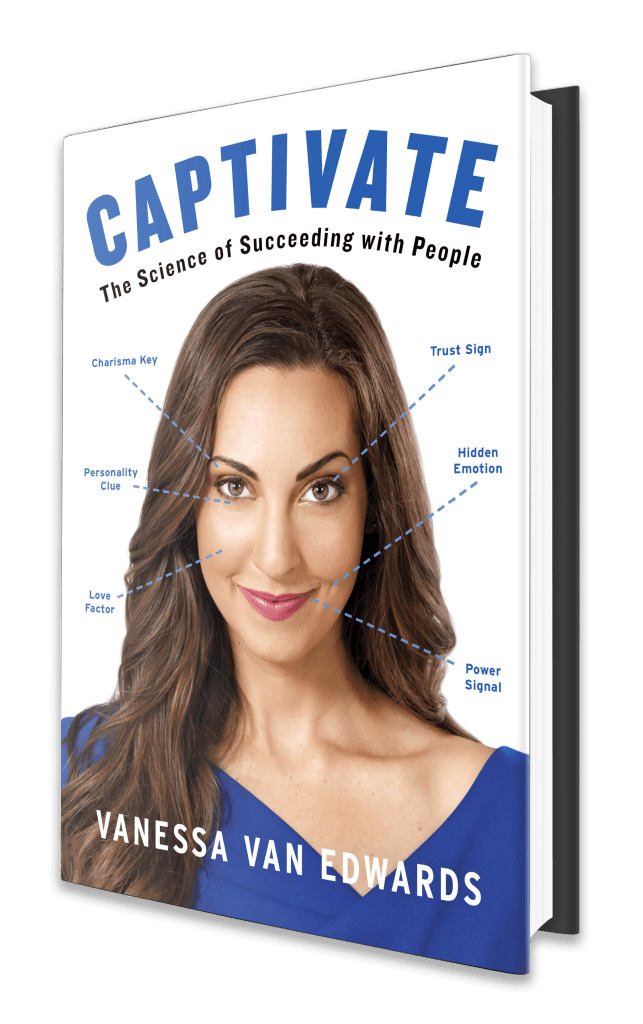
Want more interesting tips? I talk all about the science of creating pleasurable and memorable conversations in Chapter 3 of my latest book, Captivate.
Now that you’re on your way to perfecting your digital brand, I want to show you how to succeed with people—your boss, your colleagues, your friends and family.
This is the first comprehensive, science-backed, real-life manual on human behavior and a completely new approach to building connections.
You can have all the best LinkedIn profile tips in the world, but it all starts with your social skills to build up a great network.
Encourage Efficiency
Here’s a LinkedIn profile tip for the busy:
- You are busy.
- Your followers are busy.
- Your VIPs on LinkedIn are especially busy.
People are busy. So what’s the best thing you can do?
Help people engage with you in the fastest way possible. They don’t have time to spend hours every week scrolling through the platform looking for insights. So, they’re drawn to posts that deliver the most information while demanding the least amount of their time. This fact is supported by LinkedIn’s own research. They found:
- Posts featuring statistics and links to articles for more information receive a 37% higher click-through rate than those that don’t feature statistics.
- Individuals who crafted posts that were 150 characters or fewer (often with an accompanying link) received an 18% increase in engagement rate.
- Word choice can have dramatic effects on how your post is perceived. LinkedIn’s research found vast variations in engagement rates between posts that were identical, with the exception of one or two keywords. While there is no magic formula to choose the right keywords, you carefully should consider the connotations of your words to make sure they appeal to your target audience. The easiest way to do this is to mimic the jargon that your target audience uses to describe themselves and what they do.
- If you write articles, tell your audience exactly what they’re getting. People don’t want to waste time by clicking on an article, getting a few paragraphs in, and realizing that it is not relevant to them.
Get Rid of The Fluff
According to Buzzsumo, here are some of the most popular headlines on Linkedin:
- In a Job Interview, This is How to Acknowledge Your Weaknesses (33,000 shares)
- If You Want to Be Successful, You Need to Be Relevant (32,000 shares)
- Why You Should Have At Least 1 Hour THINKING Time Every Day (16,000 shares)”
Notice how each of those headlines communicates to readers that they are going to learn one specific lesson that is going to help them become more successful.
Before posting anything on LinkedIn, always ask yourself:
“Will what I post provide value for the people who read it?”
The answer determines whether something is worth sharing.
Right Now: Punch up your posts. Make them catchy or delete them.
Optimize for Your Audience
Your LinkedIn profile should be geared toward the right people, not all people. Think about your target audience or demographic. Who are your people? The target audience you need to appeal to is the group of people you depend on to become more successful. Here are some examples:
- If you’re climbing your industry’s ladder, you need to prove to your peers and superiors that you are the right fit for advanced opportunities.
- If you’re a freelancer, your target audience is not other freelancers — it’s the clients you hope to gain. Take Elna Cain’s LinkedIn profile, for example:
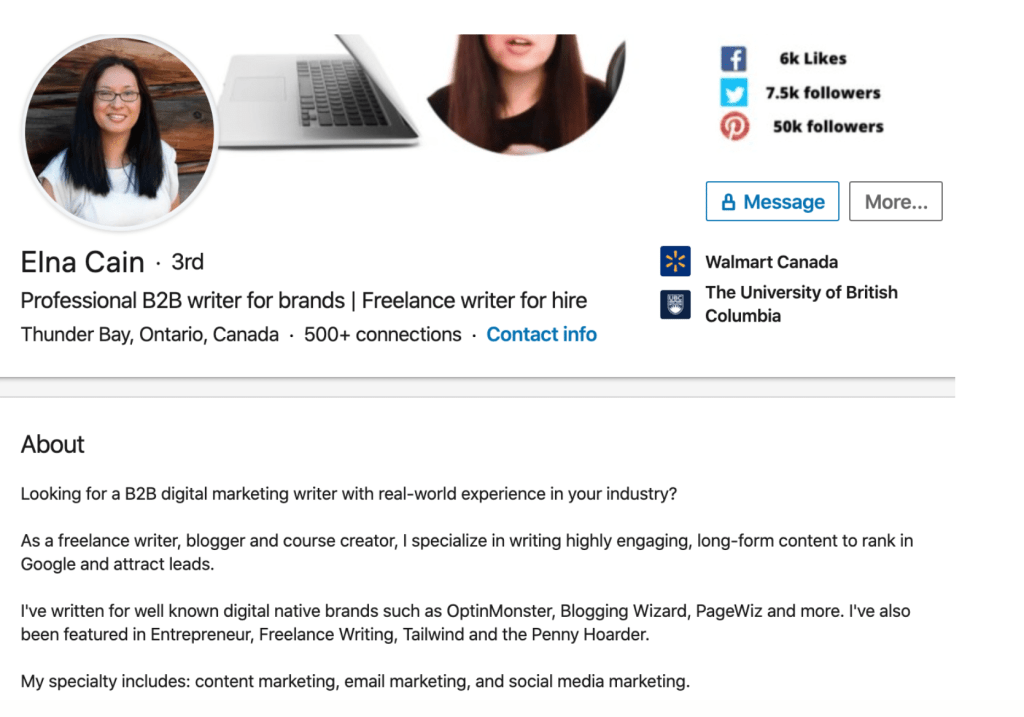
Elna’s introduction asks a question right away that targets clients who are looking for a digital marketing writer. She also lists her specialties and previous works, which helps convince clients of her experience. This helps her narrow down her target client and weeds out the rest.
- If you are looking to switch industries, be on top of everything happening in the industry you want to transition to, share what you learn, and contribute to online discussions about the industry to prove that you would be an asset to a company in that space. Also, remove current career jargon from your profile that will confuse recruiters in the industry you are transitioning to, and tailor your descriptions to match the needs of your ideal job.
- If you are looking to form connections with a particular type of person, address them directly so they know you want them to reach out to you. Here’s an example:
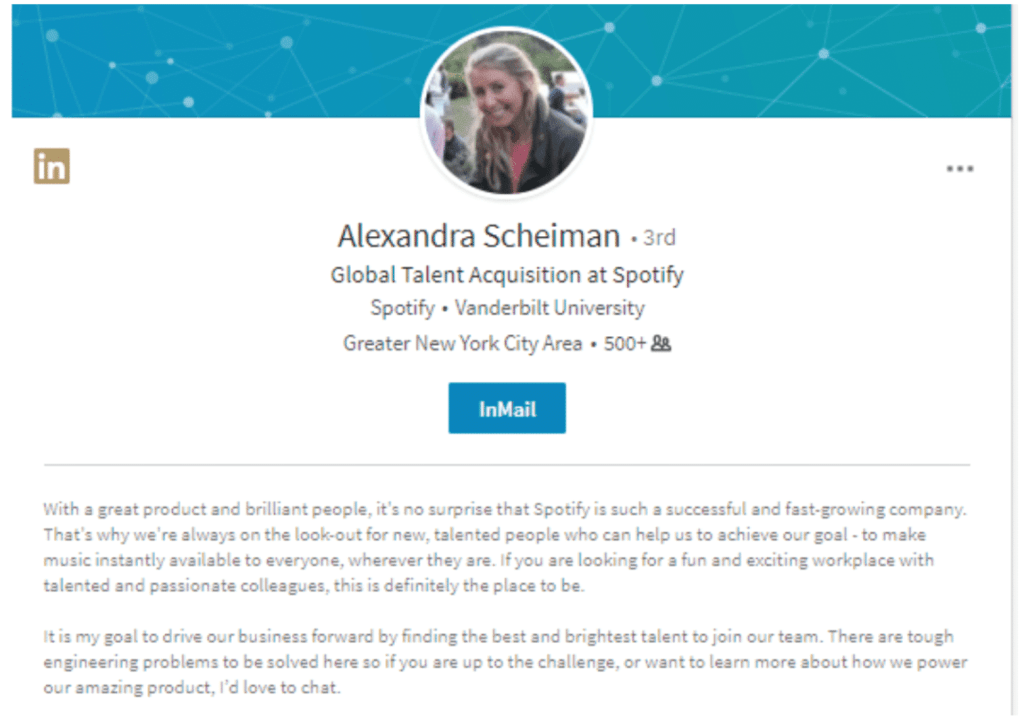
As a recruiter, Alexandra’s networking priority is making connections with potential job candidates. She does this in two ways:
- She describes the type of candidate she is looking for.
- By directly stating that she would love to chat with people who fit the bill, she encourages her ideal prospects to reach out to her.
This saves time by reducing the amount of effort she has to invest in identifying people to connect with, and deters people who do not fit her targeted demographic from trying to take up her time for unsolicited purposes.
Insider Tip: If you want people to reach out to you, make sure your profile includes your preferred contact information. By default, you likely have your email displayed, but if your inbox consistently is overloaded and social media is a more effective way to get in touch with you, mention that.
Right Now: Tailor your profile for your people and consider adding contact info.
Focus on Your Industry
According to LinkedIn, more than sixty percent of users are interested in posts about industry insights. Whether you set aside time to do research and create original posts, or you opt to share the posts of industry experts—
Updating your connections about your industry, rather than your career, is an effective way to increase your influence.
Doing so proves you are up-to-date in your industry (in other words, you’re someone who is well-informed and would be great to work with) and it allows you to provide value to your connections, who will then associate you with the benefits they gain from the knowledge you share.
If you opt to write articles, here are some tips to get you started. Search engine optimization and online marketing expert Paul Shapiro analyzed 3,000 articles on LinkedIn and discovered these trends among the most popular posts:
- Write “How” and list posts (like this one!). These types of articles directly convey the value that readers are going to get from them and outperform other types.
- Provide in-depth insights about your subject. Readers on LinkedIn appreciate content that teaches them valuable information for their careers—and that requires length. The most successful posts are between 1,900-2,000 words.
- Include images. Articles with eight images received the highest average number of views.
- Reign in your passion. While you may have strong feelings regarding an industry event that you’re analyzing, it is best to keep your emotions to yourself. Content with a neutral tone outperforms pieces with a positive or negative one. Focusing on the facts and on objective analysis will build your reputation as a competent professional and prevent you from alienating peers with different opinions.
If you have a blog, don’t worry about creating unique content for LinkedIn to avoid duplicate content. Instead, take the articles from your blog and repurpose them to appear like new content on LinkedIn. Here are a few ways to transform your content:
- Rewrite the intro paragraph. Try asking a question, starting with a statistic, or writing a personal story. Change it up!
- Change the title and subheadings. Make sure the most important words of your article are in the title and subheadings. This helps with those readers who are skimmers and don’t like to read the small text.
- Add new examples. Use images, videos, and personal anecdotes to connect your audience to your content.
- Replace the images. Replace your old/outdated images that just aren’t working with new ones. Try Unsplash or Pixabay for free images!
- Edit the intro sentences to various paragraphs. Try fleshing out your intro to make it more engaging.
- Add or take away your content. You can also try to add/remove a few hundred words from the length of the article.
Any combination of these actions will alter your content enough to appear original to readers who aren’t fanatics.
If you don’t have a website but want to write a blog, LinkedIn is a great place to start. Simply write and publish articles as you would if you had a website and pay attention to the feedback people give you so you can improve. To give your content greater reach, also share it on your other social media platforms.
Right Now: Write one article for your industry.
Don’t Give; Don’t Take… Match!
How do individuals get the most value out of using LinkedIn? Pick one answer and find out if you are right!
Question: Individuals reported gaining the most value from LinkedIn when they focused on what?
- Seeking out new jobs
- Sharing professional resources
- Building their network
- Writing new content
Hard question, but the correct answer is b!
A study published in the International Journal of Social Media and Interactive Learning Environments found that individuals report gaining the most value from LinkedIn when they focus on sharing professional resources, not directly on building themselves up.
The reason for this stems from the desire that most people have to foster reciprocal relationships.
Organizational psychology researcher Adam Grant studied more than 30,000 professionals across multiple industries and found one striking similarity between most LinkedIn users: the majority of people have a sharing mentality; they are willing to offer value to others with the expectation that other people will offer value in return.
Basically, LinkedIn users can be grouped into three different categories: Givers, takers, and matchers.
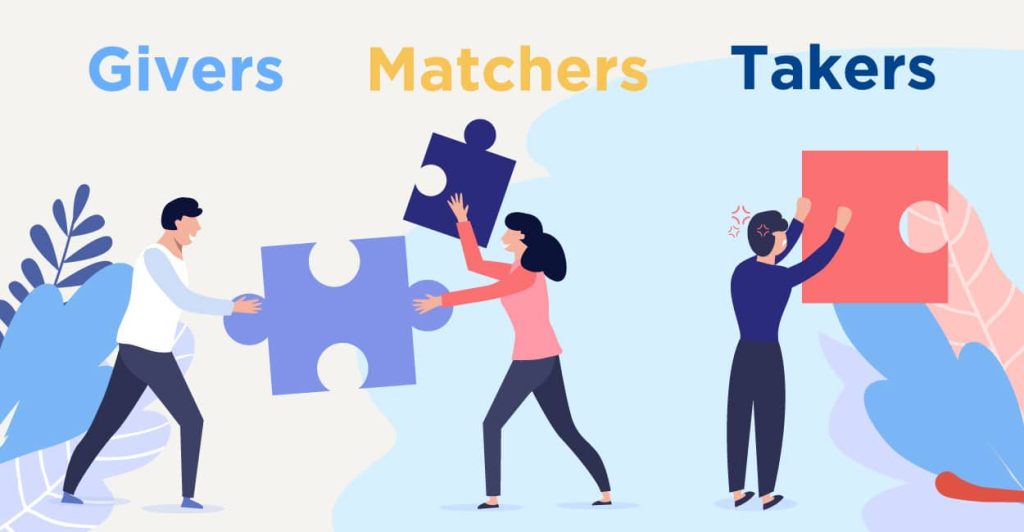
- Givers constantly go out of their way to help others without asking for anything in return.
- Takers, on the other extreme, relentlessly pursue their goals without regard for the people they use along the way.
- Matchers are those who strive for fairness.
Can you guess who succeeded the most?
Grant found that people in the Givers category fail because they focus so much on other people that they run out of time and energy to improve their own careers. If this sounds like you, keep in mind that people expect you occasionally to ask for help and do some self-promotion. It doesn’t make you a burden on others.
What about the Takers? They weren’t much better off. Takers fail because matchers turn against them. They do not like people who constantly ask for help and promote their own self-interests without taking time also to support others. On LinkedIn, this dislike translates into people refusing to engage with takers both online and offline.
Both these groups tend to be less successful than the Matchers who strive for fairness. In short: want to succeed? Be a matcher!
Here are specific ways to give back to your network and prove you’re not a taker:
- Be the bridge between people. If you have two or more connections who are looking for people like each other, introduce them.
- Endorse the people you’ve had successful working relationships with. Do more than click to endorse your connections’ skills. Take a few minutes to write a sincere testimonial about their abilities and character.
- Share your insights. If you’re an expert on a particular topic, share information that is relevant to your overall network and respond to questions related to it.
Right Now: Introduce two people who you think should know each other.
Masterful Networking
You could have a flawless LinkedIn profile with every section filled out with standout accomplishments, five hundred-plus connections, and dozens of skill endorsements, but it all will mean little if you don’t keep in touch with your connections.
Here’s the biggest mistake people make on LinkedIn: You meet someone in real life… connect with them on LinkedIn… and then a year later expect them to help you get a job at their company when you suddenly find yourself looking for new work.
This is a grade A recipe for LinkedIn failure!
But I understand! You want to keep in touch with everyone, but if you have hundreds of connections, trying to keep in touch with them can seem like a daunting task.
So how do you keep in touch with your LinkedIn connections?
The key is you only need to keep in touch with professional connections once every month or two to stay relevant in their minds. This can be done in just a few minutes a day!
Here are a few quick ways to stay in touch:
- Congratulate people on promotions and when their company is featured in the news for something positive. The easiest way to do this is to check your LinkedIn notifications to see who has found new work or been promoted recently, then set up Google alerts to hear news about the companies your connections work for.
- When you travel, let people know you are in their city and invite them out for coffee. This is a great way to get face time with contacts you otherwise might go months, if not years, without seeing again in person.
- Be a professional matchmaker! Introduce people to someone new. Once a month, look at your LinkedIn contacts and status updates and see if you can make any connections.
- Pass along helpful information. This could be content, new job opportunities, networking events, etc. Posting this information for your entire network to see is great. However, not everyone checks LinkedIn regularly. Whenever you come across information that would be particularly helpful to a connection you want to form a stronger relationship with, email it to them personally to show that you want to help them become more successful.
Bonus: Watch our video below to learn how to become a master networker and check out our article: 10 Steps to Being a Master Networker
Want to learn more of my networking strategies? I have an entire guide for networking here.
Find Your Relevant People
Want to know if your LinkedIn effort is paying off? Want to know how you are coming across? There is an overlooked section of your LinkedIn profile that most people ignore, and the last LinkedIn profile tip that can take you to the next level.
It’s the “People Also Viewed” section on the right-hand side of your profile. This updates all the time, based on what people who are searching for you are also looking at. For example, here is mine today:
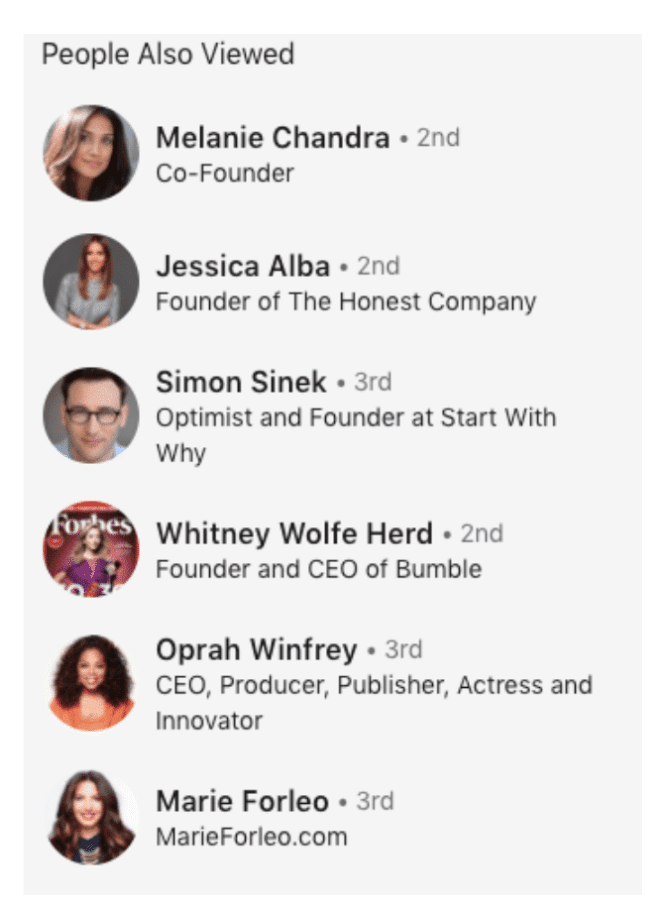
I was shocked to see this! I never know what kind of profiles people are looking at compared to mine, but I was pleasantly surprised with this list. This info is extremely useful if you know how to leverage it.
- Who does LinkedIn think is related to you? Are you being paired with people in your similar industry? With your similar title? Do you like who you are being paired with? You can get an idea of who LinkedIn thinks you are by who they pair you with, and then either leverage it or change it. For example, if you sell software and notice you are being paired with a lot of people in software, this might be good or bad. Would you prefer sales? Or tech? You can change wording in your profile and your contacts to better fit your goal.
- Can you connect? If they are coming up in your related search, you likely are coming up in theirs. Can you connect with them? I have reached out to big VIPS who came up in my related search and said, “I saw you came up in my People Also Viewed section of LinkedIn today and thought we should connect since we seem to be in similar circles.” It’s a great motivation to connect.
- Who is looking? You also might be able to make some guesstimations regarding who is viewing your profile on a given day. For example, I do a lot of spokesperson work and had a sneaking suspicion that was changing my “People Also Viewed” section. Sure enough, my manager got an email today from a company wanting to do a spokesperson deal. My guess is her and her media agency were looking around. I also guess that they also are considering Whitney Wolfe Herd, Marie Forleo, and Melanie Chandra for the deal. Now I know who else is in the running!
Right Now: See who you are paired with and take action!
Summary: Your LinkedIn Tips To-Do List
Here is a quick to do list from this article that you can do with your LinkedIn profile right now:
- Pick your theme and post an update.
- Like at least three updates from your newsfeed.
- Complete all sections of your LinkedIn profile.
- Replace those 10 buzzwords in your profile.
- Add to someone’s post.
- Selectively import contacts from your address book.
- Join a group and answer 3 questions!
- Punch up your posts. Make them catchy or delete them.
- Tailor your profile for your people, and consider adding contact info.
- Write one article for your industry.
- Introduce two people who you think should know each other.
- See who you are paired with and take action!
Start right now to boost your LinkedIn network and supercharge your profile. And remember, small steps matter.


